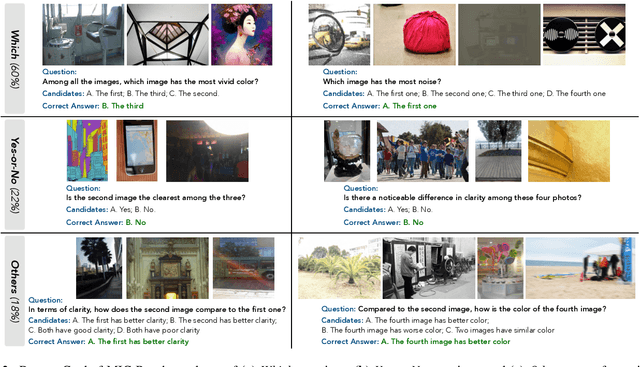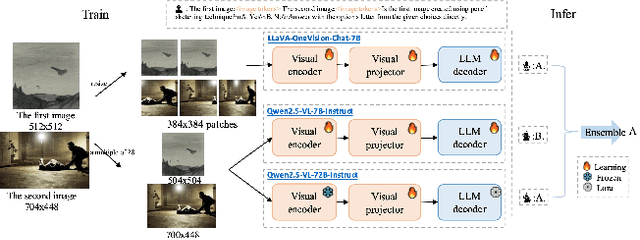Yixuan Li
Learning Sparse Approximate Inverse Preconditioners for Conjugate Gradient Solvers on GPUs
Oct 31, 2025Abstract:The conjugate gradient solver (CG) is a prevalent method for solving symmetric and positive definite linear systems Ax=b, where effective preconditioners are crucial for fast convergence. Traditional preconditioners rely on prescribed algorithms to offer rigorous theoretical guarantees, while limiting their ability to exploit optimization from data. Existing learning-based methods often utilize Graph Neural Networks (GNNs) to improve the performance and speed up the construction. However, their reliance on incomplete factorization leads to significant challenges: the associated triangular solve hinders GPU parallelization in practice, and introduces long-range dependencies which are difficult for GNNs to model. To address these issues, we propose a learning-based method to generate GPU-friendly preconditioners, particularly using GNNs to construct Sparse Approximate Inverse (SPAI) preconditioners, which avoids triangular solves and requires only two matrix-vector products at each CG step. The locality of matrix-vector product is compatible with the local propagation mechanism of GNNs. The flexibility of GNNs also allows our approach to be applied in a wide range of scenarios. Furthermore, we introduce a statistics-based scale-invariant loss function. Its design matches CG's property that the convergence rate depends on the condition number, rather than the absolute scale of A, leading to improved performance of the learned preconditioner. Evaluations on three PDE-derived datasets and one synthetic dataset demonstrate that our method outperforms standard preconditioners (Diagonal, IC, and traditional SPAI) and previous learning-based preconditioners on GPUs. We reduce solution time on GPUs by 40%-53% (68%-113% faster), along with better condition numbers and superior generalization performance. Source code available at https://github.com/Adversarr/LearningSparsePreconditioner4GPU
HoloCine: Holistic Generation of Cinematic Multi-Shot Long Video Narratives
Oct 23, 2025Abstract:State-of-the-art text-to-video models excel at generating isolated clips but fall short of creating the coherent, multi-shot narratives, which are the essence of storytelling. We bridge this "narrative gap" with HoloCine, a model that generates entire scenes holistically to ensure global consistency from the first shot to the last. Our architecture achieves precise directorial control through a Window Cross-Attention mechanism that localizes text prompts to specific shots, while a Sparse Inter-Shot Self-Attention pattern (dense within shots but sparse between them) ensures the efficiency required for minute-scale generation. Beyond setting a new state-of-the-art in narrative coherence, HoloCine develops remarkable emergent abilities: a persistent memory for characters and scenes, and an intuitive grasp of cinematic techniques. Our work marks a pivotal shift from clip synthesis towards automated filmmaking, making end-to-end cinematic creation a tangible future. Our code is available at: https://holo-cine.github.io/.
Learning Human-Humanoid Coordination for Collaborative Object Carrying
Oct 16, 2025Abstract:Human-humanoid collaboration shows significant promise for applications in healthcare, domestic assistance, and manufacturing. While compliant robot-human collaboration has been extensively developed for robotic arms, enabling compliant human-humanoid collaboration remains largely unexplored due to humanoids' complex whole-body dynamics. In this paper, we propose a proprioception-only reinforcement learning approach, COLA, that combines leader and follower behaviors within a single policy. The model is trained in a closed-loop environment with dynamic object interactions to predict object motion patterns and human intentions implicitly, enabling compliant collaboration to maintain load balance through coordinated trajectory planning. We evaluate our approach through comprehensive simulator and real-world experiments on collaborative carrying tasks, demonstrating the effectiveness, generalization, and robustness of our model across various terrains and objects. Simulation experiments demonstrate that our model reduces human effort by 24.7%. compared to baseline approaches while maintaining object stability. Real-world experiments validate robust collaborative carrying across different object types (boxes, desks, stretchers, etc.) and movement patterns (straight-line, turning, slope climbing). Human user studies with 23 participants confirm an average improvement of 27.4% compared to baseline models. Our method enables compliant human-humanoid collaborative carrying without requiring external sensors or complex interaction models, offering a practical solution for real-world deployment.
Hybrid Reinforcement: When Reward Is Sparse, It's Better to Be Dense
Oct 08, 2025



Abstract:Post-training for reasoning of large language models (LLMs) increasingly relies on verifiable rewards: deterministic checkers that provide 0-1 correctness signals. While reliable, such binary feedback is brittle--many tasks admit partially correct or alternative answers that verifiers under-credit, and the resulting all-or-nothing supervision limits learning. Reward models offer richer, continuous feedback, which can serve as a complementary supervisory signal to verifiers. We introduce HERO (Hybrid Ensemble Reward Optimization), a reinforcement learning framework that integrates verifier signals with reward-model scores in a structured way. HERO employs stratified normalization to bound reward-model scores within verifier-defined groups, preserving correctness while refining quality distinctions, and variance-aware weighting to emphasize challenging prompts where dense signals matter most. Across diverse mathematical reasoning benchmarks, HERO consistently outperforms RM-only and verifier-only baselines, with strong gains on both verifiable and hard-to-verify tasks. Our results show that hybrid reward design retains the stability of verifiers while leveraging the nuance of reward models to advance reasoning.
Detecting Distillation Data from Reasoning Models
Oct 06, 2025Abstract:Reasoning distillation has emerged as an efficient and powerful paradigm for enhancing the reasoning capabilities of large language models. However, reasoning distillation may inadvertently cause benchmark contamination, where evaluation data included in distillation datasets can inflate performance metrics of distilled models. In this work, we formally define the task of distillation data detection, which is uniquely challenging due to the partial availability of distillation data. Then, we propose a novel and effective method Token Probability Deviation (TBD), which leverages the probability patterns of the generated output tokens. Our method is motivated by the analysis that distilled models tend to generate near-deterministic tokens for seen questions, while producing more low-probability tokens for unseen questions. Our key idea behind TBD is to quantify how far the generated tokens' probabilities deviate from a high reference probability. In effect, our method achieves competitive detection performance by producing lower scores for seen questions than for unseen questions. Extensive experiments demonstrate the effectiveness of our method, achieving an AUC of 0.918 and a TPR@1% FPR of 0.470 on the S1 dataset.
How Well Can Preference Optimization Generalize Under Noisy Feedback?
Oct 01, 2025Abstract:As large language models (LLMs) advance their capabilities, aligning these models with human preferences has become crucial. Preference optimization, which trains models to distinguish between preferred and non-preferred responses based on human feedback, has become a crucial component for aligning LLMs. However, most existing works assume noise-free feedback, which is unrealistic due to the inherent errors and inconsistencies in human judgments. This paper addresses the impact of noisy feedback on preference optimization, providing generalization guarantees under these conditions. In particular, we consider noise models that correspond to common real-world sources of noise, such as mislabeling and uncertainty. Unlike traditional analyses that assume convergence, our work focuses on finite-step preference optimization, offering new insights that are more aligned with practical LLM training. We describe how generalization decays with different types of noise across levels of noise rates based on the preference data distribution and number of samples. Our analysis for noisy preference learning applies to a broad family of preference optimization losses such as DPO, IPO, SLiC, etc. Empirical validation on contemporary LLMs confirms the practical relevance of our findings, offering valuable insights for developing AI systems that align with human preferences.
VQualA 2025 Challenge on Visual Quality Comparison for Large Multimodal Models: Methods and Results
Sep 11, 2025



Abstract:This paper presents a summary of the VQualA 2025 Challenge on Visual Quality Comparison for Large Multimodal Models (LMMs), hosted as part of the ICCV 2025 Workshop on Visual Quality Assessment. The challenge aims to evaluate and enhance the ability of state-of-the-art LMMs to perform open-ended and detailed reasoning about visual quality differences across multiple images. To this end, the competition introduces a novel benchmark comprising thousands of coarse-to-fine grained visual quality comparison tasks, spanning single images, pairs, and multi-image groups. Each task requires models to provide accurate quality judgments. The competition emphasizes holistic evaluation protocols, including 2AFC-based binary preference and multi-choice questions (MCQs). Around 100 participants submitted entries, with five models demonstrating the emerging capabilities of instruction-tuned LMMs on quality assessment. This challenge marks a significant step toward open-domain visual quality reasoning and comparison and serves as a catalyst for future research on interpretable and human-aligned quality evaluation systems.
GeoArena: An Open Platform for Benchmarking Large Vision-language Models on WorldWide Image Geolocalization
Sep 04, 2025



Abstract:Image geolocalization aims to predict the geographic location of images captured anywhere on Earth, but its global nature presents significant challenges. Current evaluation methodologies suffer from two major limitations. First, data leakage: advanced approaches often rely on large vision-language models (LVLMs) to predict image locations, yet these models are frequently pretrained on the test datasets, compromising the accuracy of evaluating a model's actual geolocalization capability. Second, existing metrics primarily rely on exact geographic coordinates to assess predictions, which not only neglects the reasoning process but also raises privacy concerns when user-level location data is required. To address these issues, we propose GeoArena, a first open platform for evaluating LVLMs on worldwide image geolocalization tasks, offering true in-the-wild and human-centered benchmarking. GeoArena enables users to upload in-the-wild images for a more diverse evaluation corpus, and it leverages pairwise human judgments to determine which model output better aligns with human expectations. Our platform has been deployed online for two months, during which we collected over thousands voting records. Based on this data, we conduct a detailed analysis and establish a leaderboard of different LVLMs on the image geolocalization task.
GLSim: Detecting Object Hallucinations in LVLMs via Global-Local Similarity
Aug 27, 2025



Abstract:Object hallucination in large vision-language models presents a significant challenge to their safe deployment in real-world applications. Recent works have proposed object-level hallucination scores to estimate the likelihood of object hallucination; however, these methods typically adopt either a global or local perspective in isolation, which may limit detection reliability. In this paper, we introduce GLSim, a novel training-free object hallucination detection framework that leverages complementary global and local embedding similarity signals between image and text modalities, enabling more accurate and reliable hallucination detection in diverse scenarios. We comprehensively benchmark existing object hallucination detection methods and demonstrate that GLSim achieves superior detection performance, outperforming competitive baselines by a significant margin.
Constraint Matters: Multi-Modal Representation for Reducing Mixed-Integer Linear programming
Aug 26, 2025Abstract:Model reduction, which aims to learn a simpler model of the original mixed integer linear programming (MILP), can solve large-scale MILP problems much faster. Most existing model reduction methods are based on variable reduction, which predicts a solution value for a subset of variables. From a dual perspective, constraint reduction that transforms a subset of inequality constraints into equalities can also reduce the complexity of MILP, but has been largely ignored. Therefore, this paper proposes a novel constraint-based model reduction approach for the MILP. Constraint-based MILP reduction has two challenges: 1) which inequality constraints are critical such that reducing them can accelerate MILP solving while preserving feasibility, and 2) how to predict these critical constraints efficiently. To identify critical constraints, we first label these tight-constraints at the optimal solution as potential critical constraints and design a heuristic rule to select a subset of critical tight-constraints. To learn the critical tight-constraints, we propose a multi-modal representation technique that leverages information from both instance-level and abstract-level MILP formulations. The experimental results show that, compared to the state-of-the-art methods, our method improves the quality of the solution by over 50\% and reduces the computation time by 17.47\%.
 Add to Chrome
Add to Chrome Add to Firefox
Add to Firefox Add to Edge
Add to Edge